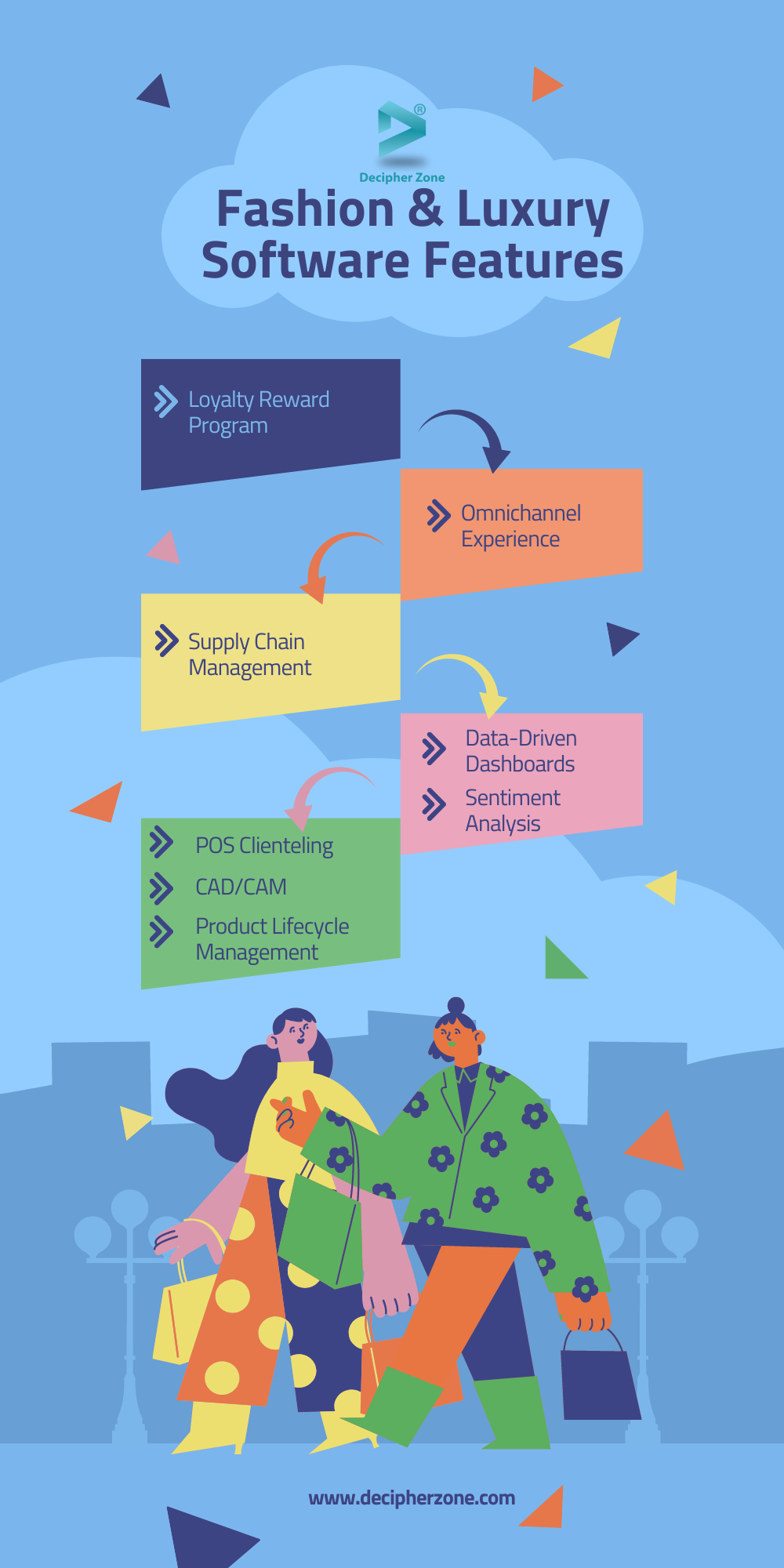Growing customer demand for digital engagement has encouraged the fashion and luxury industry to invest in technologies like advanced analytics, in-store software applications, connected stores, hyper-personalization, robotics, metaverse, etc., to gain a competitive edge.
According to Business Research Insights, the fashion and luxury software market will reach $5.29 billion at a CAGR of 8.6% by 2028. Also, based on a report from McKinsey, fashion companies are about to double their technology investment by 2030 to keep pace with digital transformation.
So, in this blog, we will cover everything from overview to types and features of fashion and luxury software solutions.
Without delaying anymore, let’s dive into the fashion industry software world.
Fashion and Luxury Software Development
Fashion and luxury software is designed to provide tools and services that centralize the management and monitoring of supplies and orders, optimize marketing strategies and streamline designs and information management.
Read: How To Build a Shopify Store for Your E-Commerce Business
In short, fashion and luxury software make the luxury fashion industry more competitive, effective, and profitable by enhancing traceability, better customer service, improved innovation opportunities, and short lead times.
Read: Web Application And Its Benefits for Business
A few reasons why you should invest in fashion and luxury software development are:
-
Automate redundant and time-consuming tasks to help the team focus on creating high-quality product collections.
-
Help control operating and product margins using actionable insights.
-
Optimize collection assortment to improve retail value.
-
Ensure product design and quality.
-
Streamline processes to improve time to retail.
Features and Strategies to Consider for Thriving Fashion and Luxury Software
With a basic understanding of fashion and luxury software, it is time to look at the must-have features and strategies you need to consider.
Loyalty Rewards Program
A reward program for the luxury fashion industry cannot be created as any other eCommerce platform. Affluent shoppers expect the highest caliber programs. Luxury retail loyalty programs should offer exclusive experiences or limited-edition products to shoppers in exchange for redeemable points.
To make it easier for customers to track their purchases, points, and rewards, you can add a customer relationship management (CRM) system. It will also help identify high-value customers, tailored experience, data analysis, customer segmentation, and more.
Omnichannel Engagement
It refers to interaction with customers across different platforms to create seamless experiences. To maintain open communication, fashion luxury brands need to run targeted marketing campaigns on social media channels, integrate AI chatbots for quality customer support, and send customized messages on their preferred channels.
Implementing omnichannel engagement strategies will help in maintaining consistent personalization, engaging customers on their preferred channels, and gaining marketing and sales benefits.

Sentiment Analysis
Adding a tool for sentiment analysis can help fashion and luxury brands in analyzing reviews, comments, or messages and determining whether it's positive, negative, or neutral through natural language processing.
POS Clienteling
It is a technique used by retailers to create long-term customer relationships using data about their behaviors, purchases, and preferences.
As luxury fashion shoppers have higher expectations for personalized experiences, integrating an ERP point of sales system can help in real-time reporting, automating data entry, and accessing warranty reporting that foster improved customer loyalty and experience.
Supply Chain Management
Integrating SCM software in fashion and luxury solutions helps in managing supply chain activities including but not limited to transactions, shipments, logistics, vendor management, fulfillment, inventory management, and transportation mode.
Data-Driven Dashboards
Implementing data-driven dashboards allows fashion and luxury brands to quickly identify top-performing products, inventory statistics, selling patterns, and more based on key performance indicators (KPIs).
It also helps luxury retailers to make more informed decisions to increase overall business performance and ROI.
Product Lifecycle Management
It is a software integration that supports the development and management of the product lifecycle from planning to product testing, fit reviews, product quality management, supplier collaboration, and merchandising.
Product lifecycle management (PLM) integration can increase product margins and save last-minute expenses.
CAD/CAM
Computer-Aided Design and Computer-Aided Modeling are the tools that can be used in the fashion and luxury software to design and model prototypes, determine efficient cuts and patterns for fabrics, mass customization, frequent style changes, and sew clothes. CAD/CAM makes the process of designing and manufacturing a lot more streamlined and efficient.
How much does it cost to develop a Fashion and Luxury Software
Developing fashion and luxury software can cost you anywhere from $25,000 to $150,000. The cost of fashion and luxury software depends on the size, complexity, scalability, tools, technologies, and programming languages required.
Another factor affecting the fashion and luxury software development cost is the geographical location and experience of the development team you are going to outsource.
While hiring from the US or UK can cost you $40-$100 per hour, outsourcing from countries like India can reduce the per-hour cost up to $20-$50 depending on the expertise and knowledge of the team.
Conclusion
Overall, we can say that having software for the fashion and luxury industry can help accelerate design and manufacturing as well as collection assortment, streamlining processes, product lifecycle management, and reducing operational costs.
So, if you too want to reduce the time, effort, and money invested in the designing, developing, and managing of products then we can help you with that. All you have to do is contact us, share your requirements, and we will help provide you with an effective solution under your budget.
FAQs: Fashion and Luxury Software Solutions
What is fashion and luxury software?
It’s designed to provide tools and services that centralize the management and monitoring of supplies and orders, optimize marketing strategies and streamline designs and information management.
What are the must-have features of fashion and luxury software?
Loyalty Rewards Program, Omnichannel Engagement, Sentiment Analysis, POS Clienteling, Supply Chain Management, Data-Driven Dashboards, Product Lifecycle Management, and CAD/CAM are some of the must-have features you should consider while developing fashion and luxury software.

